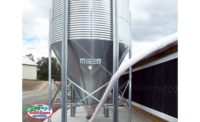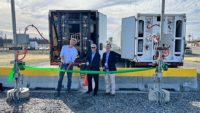Success Through Partnership
By Lisa White
Harris Ranch Beef Co. succeeds at foodservice because it is flexible and focused on making its product the highest-quality, safest beef available.
When Harris Ranch Beef Co. expanded its distribution to include foodservice operations about two and a half years ago, it was a natural progression of its vertically integrated business.
Established back in 1937 by Jack Harris, the farming and livestock operation grew and diversified into the comprehensive company that it is today. Headed by Jack’s son John, Harris Farms is one of the largest integrated farming operations in California’s Central San Joaquin Valley.
Its related companies include Harris Farms, which is comprised of 17,000 acres; the Harris Ranch Thoroughbred racehorse division; Harris Feeding Co., a 700-acre feedlot and one of the largest in the western U.S.; and the Harris Ranch Inn and Restaurant, a 185-room hotel that includes restaurants, a ballroom and convention facilities. The company also has an expanding Internet business.
According to Brad Caudill, vice president of marketing, the Harris Ranch Beef Co. is the firm’s processing arm. “One hundred percent of the beef processed comes from the Harris Feeding Co.,” he says. The company has its own cattle, feeding operations, processing center and transportation company.
A natural extension of its business, the foodservice operation was developed to augment Harris Ranch’s retail division. “We have always been retail driven, serving smaller chains. Our company was one of the first to offer value-added beef products. However, we knew we were missing out on the foodservice side,” Caudill says.
He credits John Kammeier, president of Harris Ranch Beef Co.’s foodservice division and a 30-year veteran of the industry, for the success of this new venture.
After joining Harris Ranch, Kammeier went to work developing a business model to promote, sell and market the company’s Certified Premium Beef and USDA Certified Natural Black Angus Beef foodservice products.
“We wanted to develop two brands to take to the foodservice industry,” he says. “The breed-specific program was there, so it was a matter of making sure we had the cattle supply to meet customers’ needs.”
Kammeier developed different grades of meat and a diamond system that rates quality and then created the foodservice product line. “Not all cattle is Choice, so you need a vehicle to sell the different grades,” he explains. For example, the diamond system rates the Prime Natural Black Angus at five diamonds, the upper two-thirds choice is four diamonds, the lower one-third choice is three diamonds and the upper select is two diamonds.
This product line is offered in both four-piece and 12-piece tenderloins, which gives owner/operators more flexibility. “Foodservice operators today would prefer an option on their inventory purchases. That is why we offer the two box choices,” Kammeier says.
In researching the plan, the company also discovered the need to develop non-breed-specific programs with its foodservice model to better promote its brand to distributors.
The goal, says Kammeier, is to sell these lines to customers the company already has connections with. To achieve this, its foodservice division’s three regional managers, headed by vice president of sales Todd Williams, develop relationships with chefs and restaurant operators. “We promote our products and train distributors to build brand equity,” he explains.
Kammeier emphasizes that Harris Ranch Beef Co. does not distribute its product nationally. “We are a boutique packer that processes 800 head of cattle a day. Chefs like this because we can meet any need, like subprimals or portion control,” he says. “Whether it is a New Orleans chef that needs a specific short rib or an operator in Hawaii that wants an all-natural chuck patty, we listen to operators and develop products for them. We like to be flexible.”
Caudill concurs that the company offers services others may not. “We are not a low-cost producer and we never will be. But we can compete with anyone on the basis of quality and customer service,” he says.
Production practices
What sets Harris Ranch apart is its attention to detail. The company’s “Partnership for Quality” producer program involves 70 ranching families in California, Nevada and Oregon that control 50,000 mother cows. Through this setup, the company is able to source-verify an increasing number of cattle every year. “We work to supply these farmers with bulls and genetic material based on research to produce the beef cow we are looking for,” Caudill says. “We also have longstanding relationships with other cow/calf producers.”
The company’s feed lot holds about 120,000 head of cattle that feed for a minimum of 120 days on feed ration corn brought in by train. There is a staff nutritionist that develops programs solely for the needs of the livestock.
The core of its food-safety program is a fully integrated production system. Every aspect of beef production, from cattle procurement to feeding, processing to distribution, is controlled. All cattle are fed and processed at one facility.
Young cattle, typically between 14 and 16 months of age at processing, are fed a diet consisting primarily of Midwestern corn and other locally grown feeds. Cattle rations contain no animal proteins, and incoming feedstuffs are regularly tested for unwanted pesticide residues.
Cattle are evaluated every day for health status. Those requiring treatment are moved to hospital pens, individually identified, then managed with strict adherence to health product withdrawal periods. Cattle are routinely tested for antibiotic residues through the company’s Residue Control Program.
All cattle are fed in large, well-maintained, outdoor pens that are equipped with an automated sprinkler system to reduce dust and cool cattle during the summer months.
Harris Ranch Beef Company’s processing facility is located in Selma, Calif. A trained quality assurance staff of 20 is headed by Dr. Pat Mies, quality assurance, food safety director, and works alongside the USDA to oversee all aspects of processing. The company’s HACCP-intervention program employs the use of multiple-hurdles technologies at both the production and processing levels.
The company’s cleanliness and food-safety standards are rigid. All of Harris Ranch’s trucks and trailers are cleaned in a state-of-the-art truck-washing facility before each load of cattle is transported to the processing facility. In addition, cattle are washed upon arrival to remove physical material, such as dust or manure, from the hide prior to entry into the processing area.
Intervention strategies also are employed in its processing facility. During the harvesting phase of production, the use of steam vacuums, a thermal pasteurization cabinet and carcass rinses with organic acid help eliminate cross-contamination. In addition, the use of a spray-chill system and refrigerated air quickly reduces carcass temperature. Temperature control and monitoring continues throughout the production system, including fabrication, storage and shipping areas.
Along with keeping food safety at the forefront, Harris Ranch is a forward-thinking company. “We just launched a fresh seasoned, ready-to-cook beef. It is primarily retail-driven, but also available for foodservice. We also have a whole ground beef program for retail and foodservice,” Caudill says.
From a foodservice perspective, the plan is to take its relationships and keep growing the business. “We are penetrating more areas, picking up multi-unit and regional accounts. We need to make sure we can grow and partner with our customers,” Kammeier says.
These steps will help further ensure that its foodservice arm continues on the path of success.
Lisa White is a freelance writer based in the Chicagoland area.


Report Abusive Comment